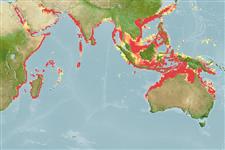Actinopterygii (ray-finned fishes) >
Perciformes (Perch-likes) >
Callionymidae (Dragonets)
Etymology: Callionymus: Greek, kallion, comparative of kallos = beautiful + Greek, onyma = name; with a better name . More on author: Valenciennes.
Environment / Climate / Range
Ecology
Marine; demersal; depth range 2 - 350 m (Ref. 58488), usually 5 - 100 m (Ref. 89972). Subtropical, preferred ?; 54°N - 29°S, 24°E - 157°E
Indo-West Pacific: Red Sea south to Delagoa Bay, Mozambique and eastward to Taiwan. Migrated to the Mediterranean Sea via the Suez Canal (Ref. 5385).
Size / Weight / Age
Maturity: Lm ? range ? - ? cm
Max length : 20.0 cm TL male/unsexed; (Ref. 4405)
Dorsal
spines
(total): 4;
Dorsal
soft rays
(total): 9;
Anal
spines: 0;
Anal
soft rays: 9. Light brown in color with dark spots on sides; fins with dark brown spots; males with black stripes or blotches on 1st dorsal fin, females with black blotch on 3rd membrane (Ref. 4405). Ventral margin of preopercular spine convex (Ref 42832).
Found on sandy and muddy substrate of the coastal area down to a depth of about 100 m (Ref. 5213). Minimum depth reported taken from Ref. 4405. Feeds on small benthic invertebrates, mainly crustaceans and worms (Ref. 5968). Minimum depth of 2 m reported from Ref. 90102.
Life cycle and mating behavior
Maturity | Reproduction | Spawning | Eggs | Fecundity | Larvae
Bauchot, M.-L., 1987. Poissons osseux. p. 891-1421. In W. Fischer, M.L. Bauchot and M. Schneider (eds.) Fiches FAO d'identification pour les besoins de la pêche. (rev. 1). Méditerranée et mer Noire. Zone de pêche 37. Vol. II. Commission des Communautés Européennes and FAO, Rome. (Ref. 3397)
IUCN Red List Status (Ref. 115185)
CITES (Ref. 94142)
Not Evaluated
Threat to humans
Harmless
Human uses
Fisheries: of no interest
More information
Common namesSynonymsMetabolismPredatorsEcotoxicologyReproductionMaturitySpawningFecundityEggsEgg development
ReferencesAquacultureAquaculture profileStrainsGeneticsAllele frequenciesHeritabilityDiseasesProcessingMass conversion
Tools
Special reports
Download XML
Internet sources
